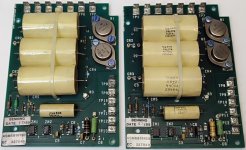I found a schematic for my JCM 900 4100, but am confirming that C4 is a film capacitor and C3 is a color coded ceramic capacitor.
We can assume different things, but there is a decoding of codes. I am waiting for an answer from the one who owns the information.
Hi Charm,
Is this a power supply?
If so, either Polyester or Polypropylene will do fine. The best way to to measure the dielectric constant, that will tell you what they are. Of course, cheap testers do not have the resolution to differentiate. Power supply bypass is different to signal coupling when there is filtering involved.
Is this a power supply?
If so, either Polyester or Polypropylene will do fine. The best way to to measure the dielectric constant, that will tell you what they are. Of course, cheap testers do not have the resolution to differentiate. Power supply bypass is different to signal coupling when there is filtering involved.
Measure the caps, take a note, throw them in freezer, 30 minutes later, take them out, measure again, if numbers are bigger its polypropylene, smaller it is polyester
Guys I do not need any advice and assumptions, but I asked for a decryption such as a dielectric. It is simply possible to buy these boards for the sake of capacitors if they are of value for sound.
Then may I suggest you pour through the data sheets yourself instead of asking someone else to do it for you?
Trw capacitors have been owned by Lockheed Martin, and American Shizuki Corporation.
As far as i could figure out
As far as i could figure out
I thank everyone who responded to help, the issue was decided differently. I already agree that the dielectric can be polypropylene, although the search for code 8410 did not give anything. But the choice disappears even by the fact that it is a noise-diving X-condenser.

0.68uf is a high value for an X cap, if it was there for noise reasons to get past the EMI regulations, they must have some nasty switchers in there.
- Home
- Design & Build
- Parts
- Identifying capacitor type
